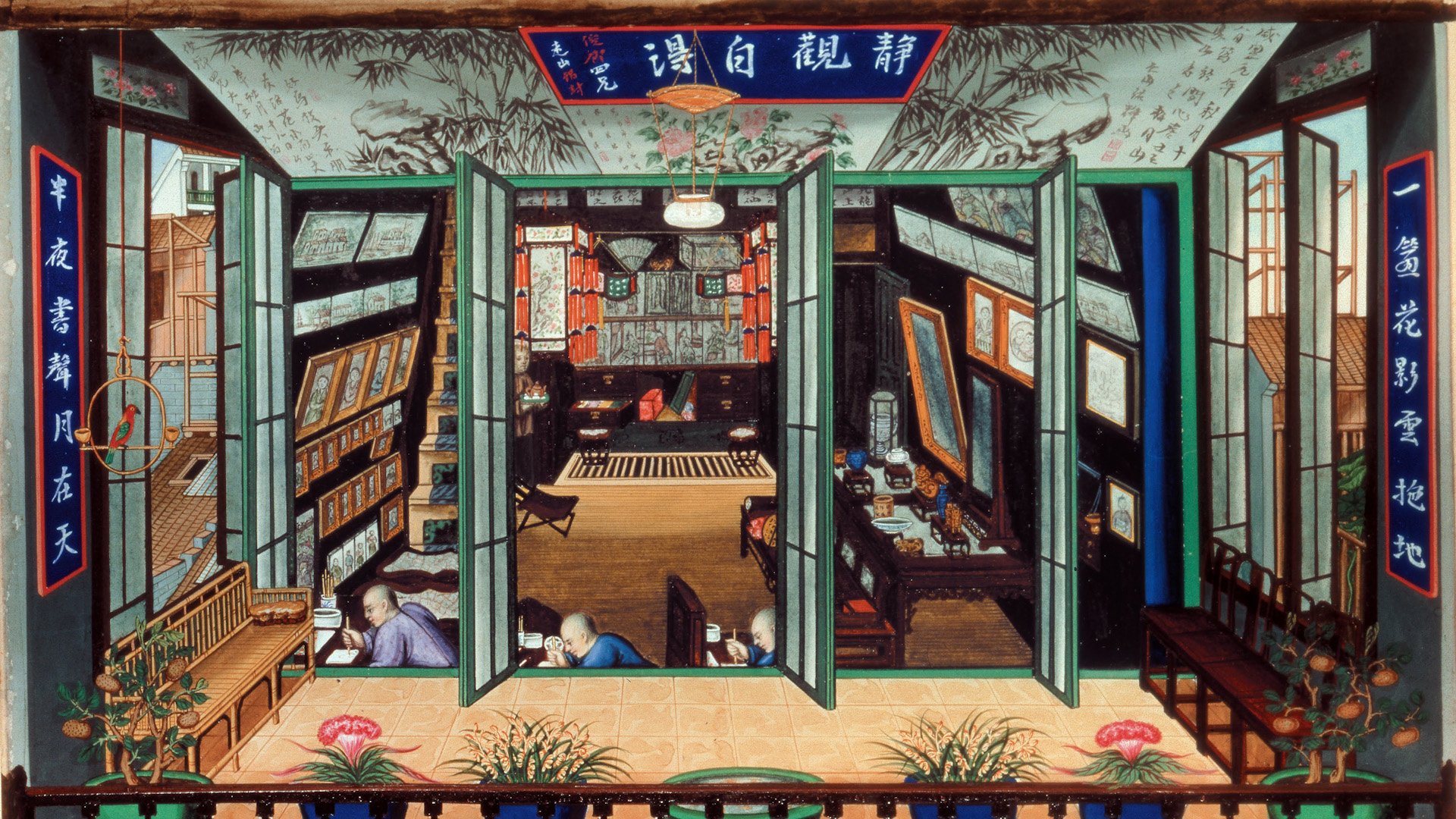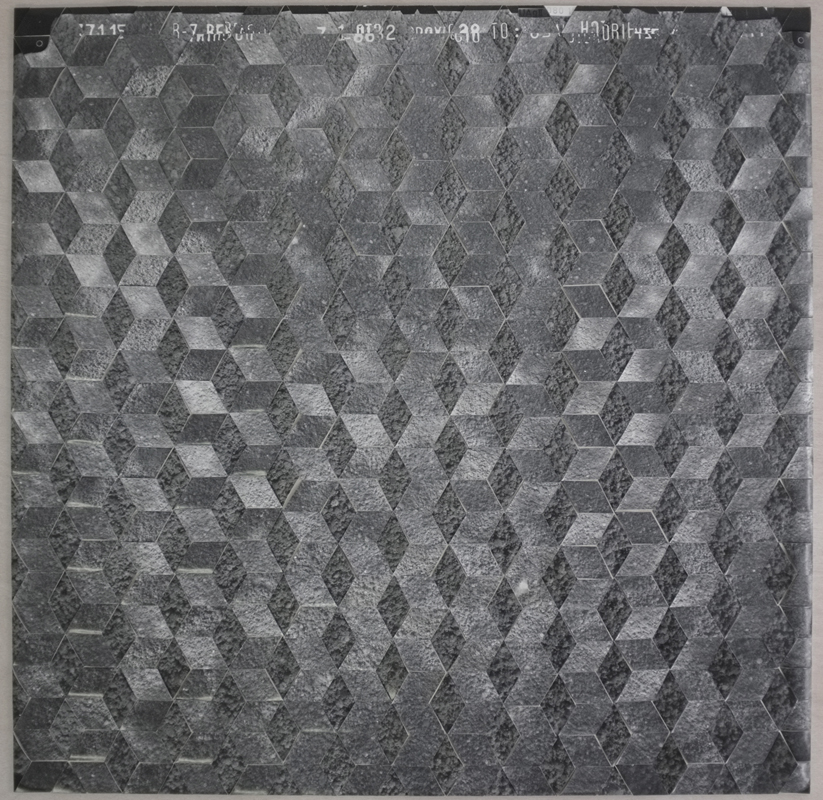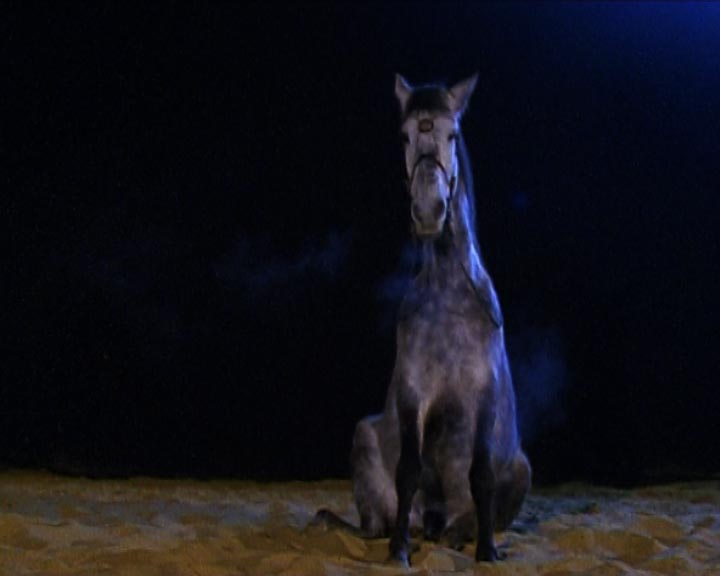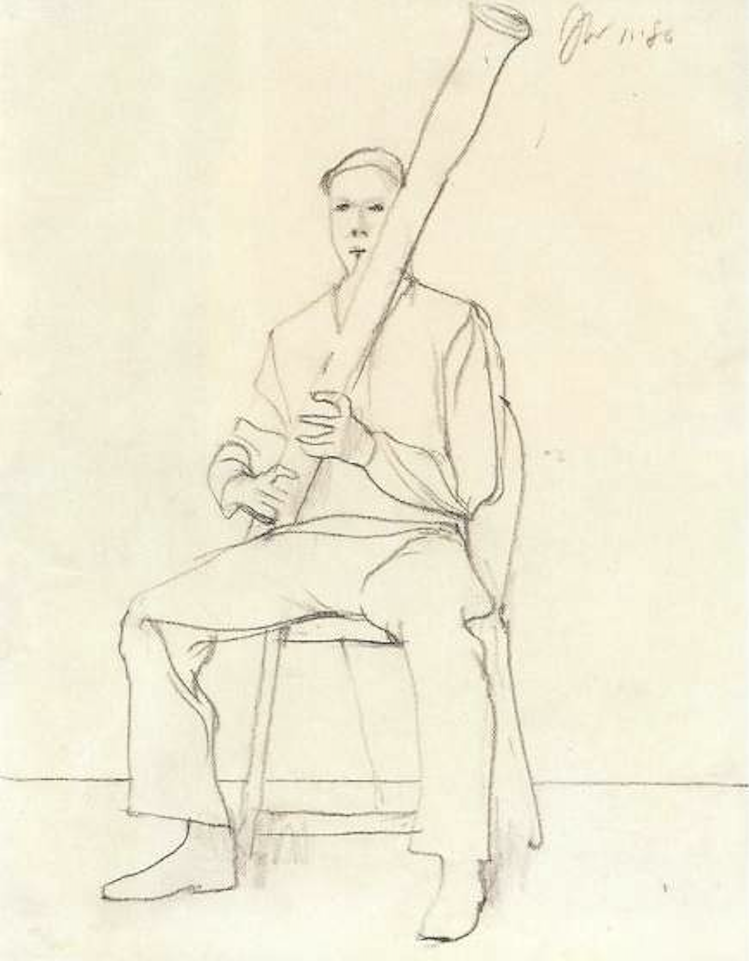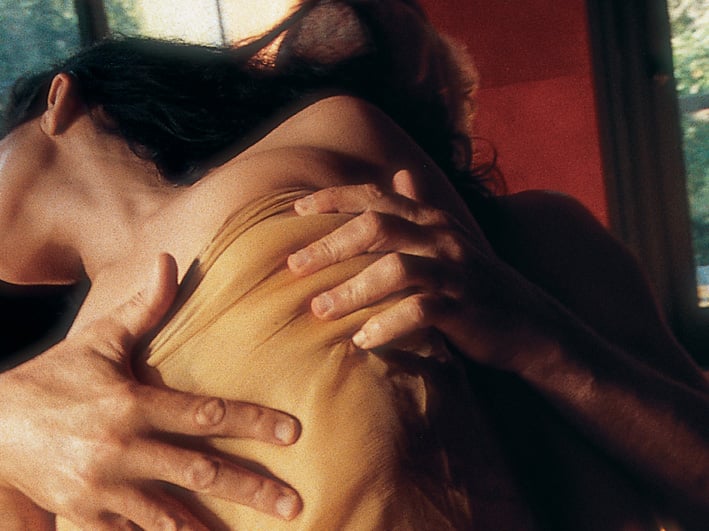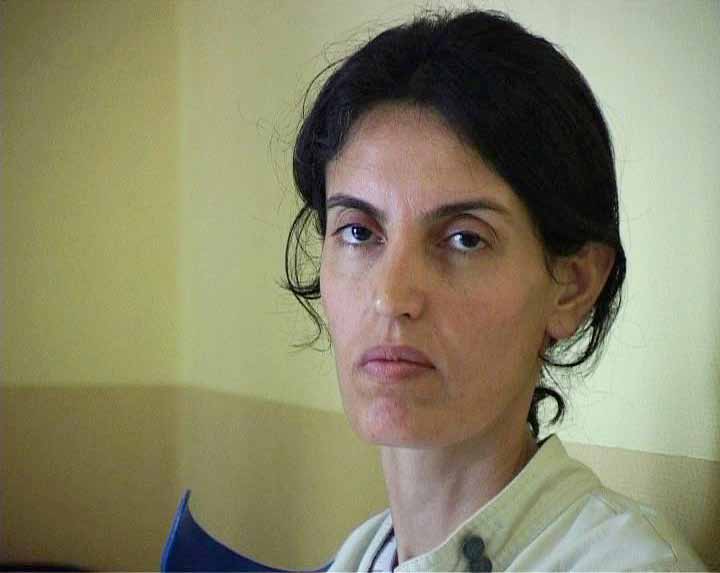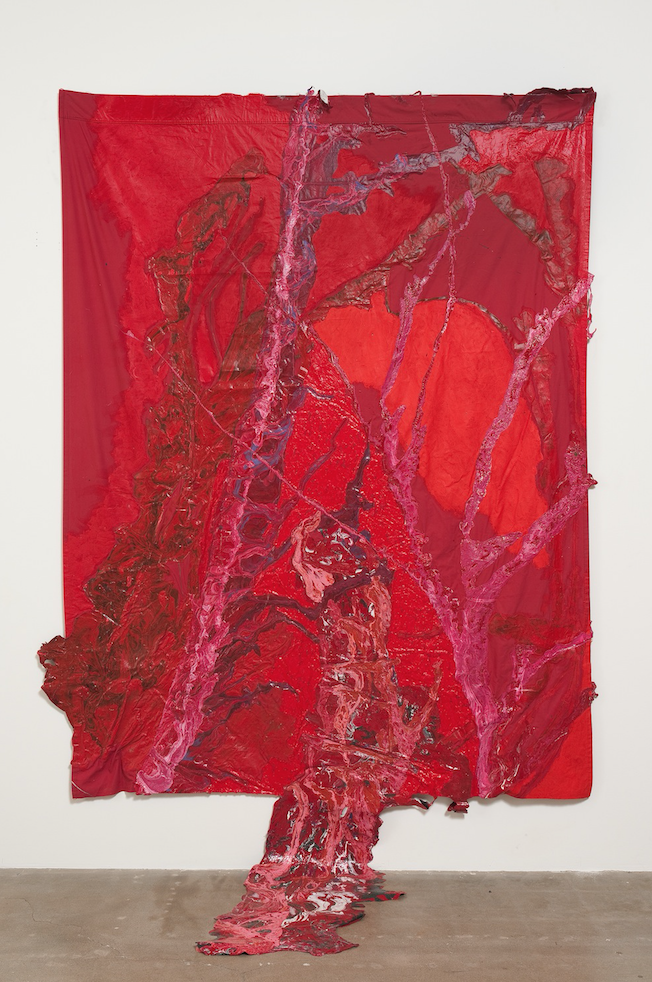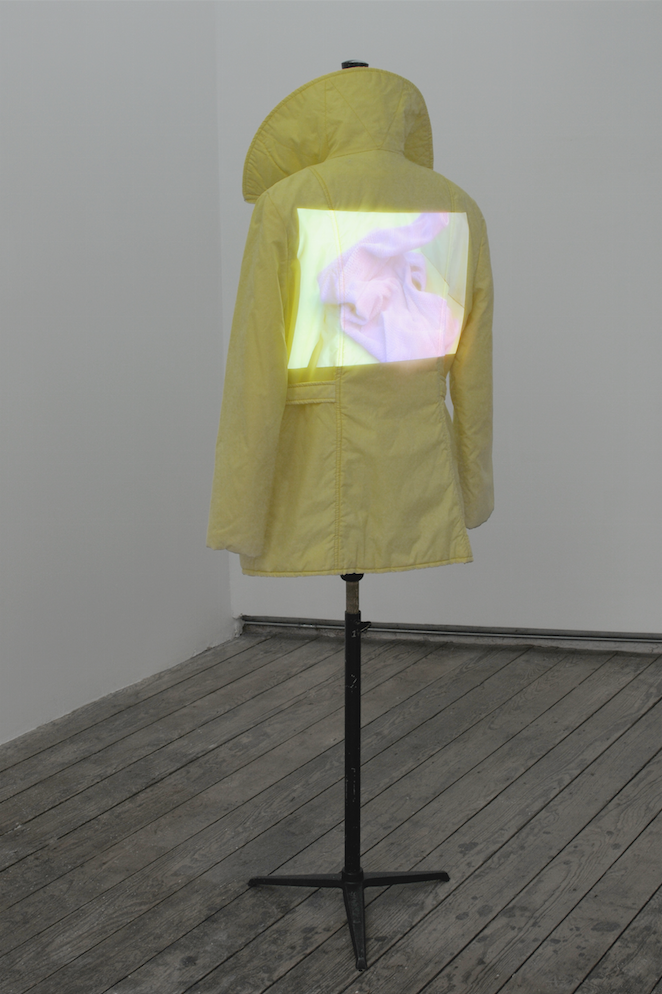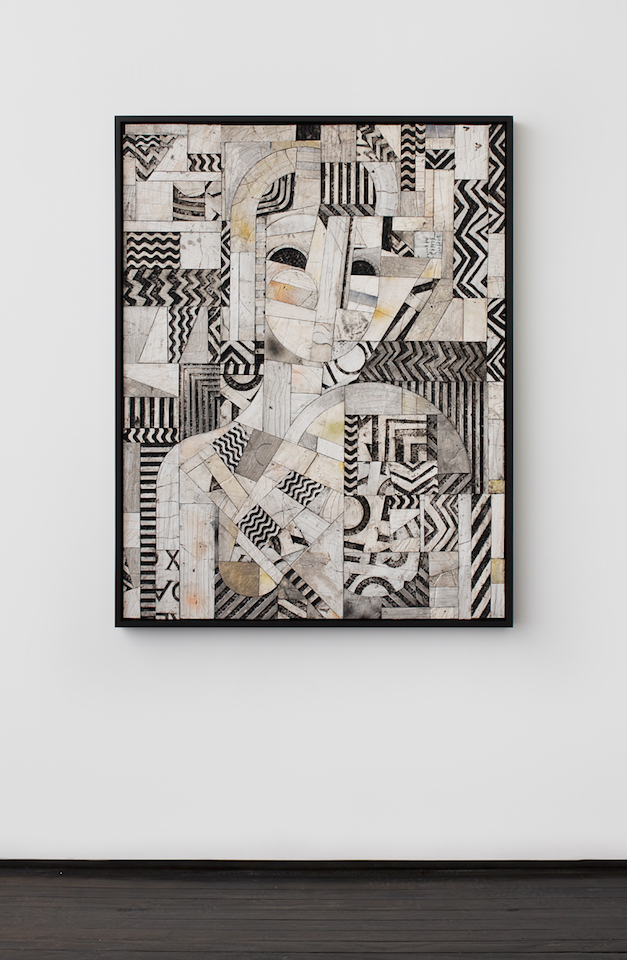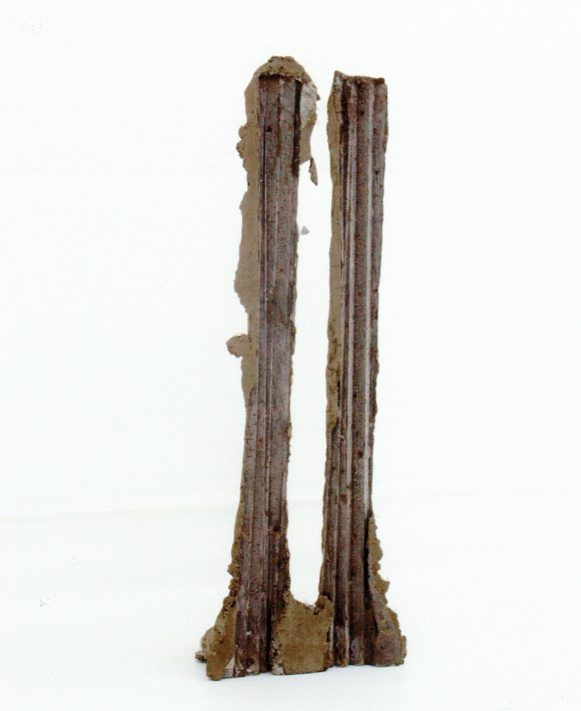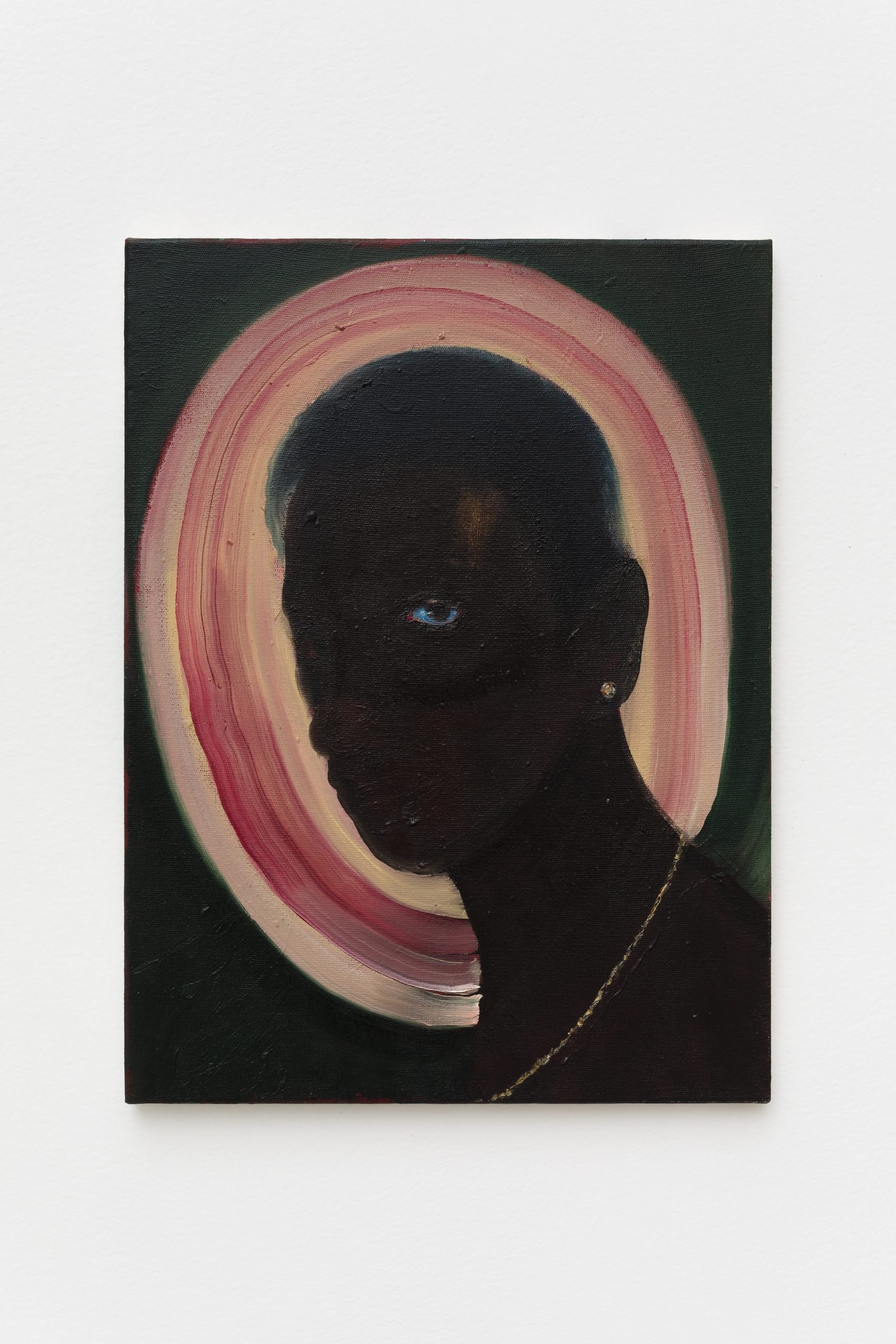
© » KADIST
Xin Liu
Living Distance by Xin Liu is a VR work and two-channel video based on a real mission in which the artist’s wisdom tooth was sent to outer space and back down to Earth again. In the VR work, users play the role of the tooth, journeying from the mouth to outer space, with a poetic narration by Liu. The piece is exquisitely rendered, with deep blacks that make the experience especially powerful on a Vive Pro.

© » KADIST
Manuel Solano
Since Manuel Solano became blind, they developed a technique that relies on audio descriptions that allow for an assistant to place pins and threads on a grid that guides the artist’s hands through the surface. In Los Abuelos , the artist works with a canvas the size of their body, allowing intense interaction with the wet paint. This kind of tactility creates a complex entanglement of color masses alternating sharp and blurred details, giving the image an erratic and affective atmosphere just as our fond memories often appear to us.

© » KADIST
Sam Contis
Sam Contis’s photographs explore the relationship of bodies to landscape, and the shifting nature of gender identity and expression. Oil is part of a photographic series Contis made at Deep Springs College, one of the United States’s last all-male institutions of higher learning, located in a remote desert valley on the California–Nevada border. Oil features a hand in front of an open hood of a car, checking the oil.

© » KADIST
Tenzing Rigdol
Unhealed by Tenzing Rigdol is a photograph of the artist’s back tattooed with a map of Tibet with the dates of important political events. Each date and region is marked with a needle, a reference to the traditional Chinese medicine method for treating ailments, used to mark the regions and dates of major uprisings and mass protests as a means of encouraging dialogue and to start the recovery process. Millions of Tibetans have died in those protests.

© » KADIST
Nontawat Numbenchapol
The series of prints titled Mr. Shadow by Nontawat Numbenchapol engages with the history of and current state of militarization in Thailand. Each print features an invisible person, their silhouette only outlined by the military fatigues that they wear.

© » KADIST
Sin Wai Kin
Drawing & Print (Drawing & Print)
A woman you thought you knew by Sin Wai Kin originates from a performance series titled A View from Elsewhere . Wearing exquisite hair and makeup and a pair of silicone breasts under shimmering diamanté lingerie, Sin Wai Kin’s former persona, Victoria Sin, assumes an alluring, inviting, and intimidating pose. Through subtle and slow movements, this atemporal courtesan appears as a living deity, whose presence embodies codes of representation found in brothels from the turn of the century, burlesque, and Beaux Arts female nude painting.

© » KADIST
Nikita Gale
RUINER III by Nikita Gale is part of an on-going numbered series of abstract sculptures in which various ancillary materials necessary for sound production and recording such as towels, foam, and audio cables, are riddled around piping resembling crowd control bollards, lighting trusses, and other like stage architecture. While these muscular works evoke the forms and dynamism of mid-century modernism, they can also be seen as a translation of Goethe’s idea that “architecture is frozen music”. RUINER III is exemplary of how the artist’s disembodied sets typically evoke a sense of longing through absence, and in so doing, draw out an extended mediation on how audiences project mental or emotional energy onto a person, object, or idea.

© » KADIST
Nontawat Numbenchapol
The series of prints titled Mr. Shadow by Nontawat Numbenchapol engages with the history of and current state of militarization in Thailand. Each print features an invisible person, their silhouette only outlined by the military fatigues that they wear.

© » KADIST
Shahryar Nashat
Employing both the High Modernist technique of abstraction and monochronism, as in the work of Lucio Fontana and Yves Klein, and bodily states of fetishization, Yea High (sweetpreparator) reworks the art historical canon of movement and the body to consider flesh as a physical construction of man-made matter. In the work, the artist uses perspiration as a medium on the surface, combing the man-made and the organic. The pink of the surface reflects the artist’s interest in reframing the way we understand the permeability of human skin.

© » KADIST
Amapola Prada
In Amapola Prada’s work Movement, we see three spotlit, female bodies lying inert in a darkened room, alongside three dressed, standing figures holding long, wooden spoons. Looking over the static bodies, the standing figures place their spoons in-between the women’s legs and begin moving them in circular, rowing-like motion, like the oars of a boat. The psycho-sexually charged nature of Movement is illustrative of Prada’s dream-like works, which often relate to the subconscious and other internal processes with which we express desires, tensions, and latent emotions.

© » KADIST
Maryam Hoseini
Secrets Between Her and Her Shadow 10 by Maryam Hoseini is from a series of paintings of the same title that are inspired by the story Layla and Majnun – an Arabic love story about Majnun, a 7th century Bedouin poet, and his lover, Layla. Hoseini’s compositions are visually inspired by the illustrations accompanying the Khamsa of Nizami , a manuscript of five poems, including Layla and Majnun , produced by the Persian poet Nizami in the 1590s. Unlike the original tale, Hoseini’s paintings focus entirely on Layla, any male characters are purposefully erased from this narrative.

© » KADIST
Karla Kaplun
Drawing & Print (Drawing & Print)
Studying the body in movement, this series of drawings depart from Karla Kaplun’s work A ztec BLAST® Workout (AWB) . Taking the form of a fitness training program, this work critically explores issues of cultural appropriation, focusing on the traditional “Conchero” Aztec dance. The Concheros dance—also known as the Chichimecas, Aztecas and Mexicas—is an important traditional dance and ceremony which has been performed in Mexico since early in the country’s colonial period.

© » KADIST
Prinz Gholam
Ein Ding Mehr , or ‘one more thing,’ is part of a long-term collaborative performance series by artists Wolfgang Prinz and Michel Gholam, which consist of the pair embodying an array of material through holding various poses for extended periods of time. As the artists perform each gesture, we see them gaze on the preparatory drawings, which act as an instructional score of sorts. The drawing itself, besides featuring carefully drawn sketches of each position, also contains a list of the source material that inspired them: a scene from Pier Paolo Pasolini’s film, Salo, Eugène Delacroix’s Pietà, and a reference to a monument by Auguste Rodin among others.

© » KADIST
Seba Calfuqueo
Alka domo by Seba Calfuqueo is a performative video work that recontextualizes a story about Caupolicán, the Mapuche toki (meaning symbol of strength and perseverance in the face of adversity). Caupolicán was elected military leader by the Mapuche people of Chile after successfully completing the challenge of holding a log on his shoulders for two days. Caupolicán led the Mapuche army in the first uprising against the Spanish conquistadors from 1553 to 1558.

© » KADIST
Adelita Husni-Bey
After the Finish Line is a recent film by Adelita Husni-Bey produced for the exhibition Movement Break at Kadist-SF in 2015. It was developed in collaboration with a group of teenage athletes who have experienced injury as a result of their respective sporting activities. Through radical pedagogical practice, a process that attempts to de-individualize feelings of failure, the artist and the athletes recorded their experiences, discussing the meaning and trappings of competition — and in particular, from where desires for success stem.

© » KADIST
Christina Quarles
The title of the painting refers to the fact that the figure’s behind is raised upwards and the face is found at the bottom of the painting, thus inverting the way in which people are normally seen. Bottom’s up is also a pun, a nod to the English toast. Quarles draws on a number of sources of inspiration, including comic book imagery, the influence of which sits alongside elements of her practice informed by life drawing classes.
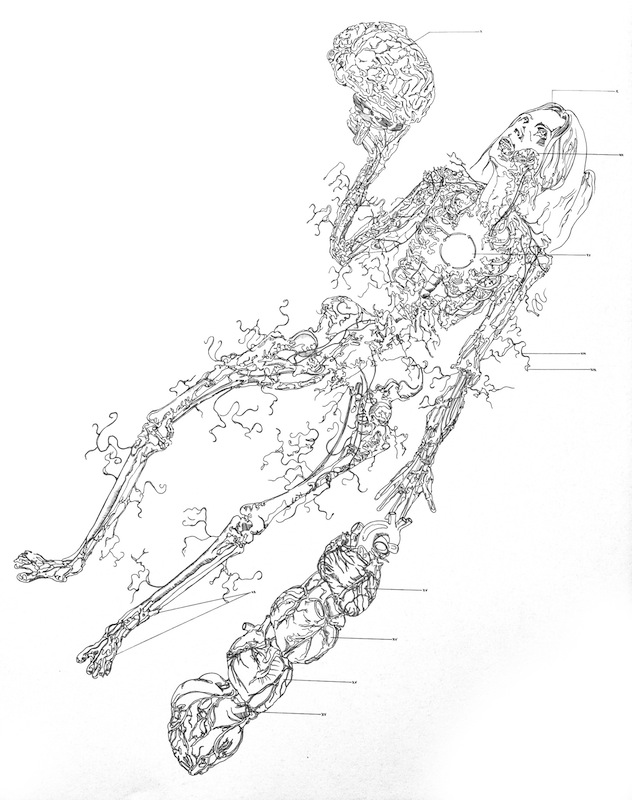
© » KADIST
George Pfau
Drawing & Print (Drawing & Print)
This work exemplifies George Pfau’s interest in zombies and liminal embodiment. In different ways, zombies are present here as an icon of coming apart, yet they retain a persistent thereness. In Zombie Examined, the frayed edges of the body are undone by a clinical look, rather than a visual effect.

© » KADIST
John Lucas and Claudia Rankine
Drawing & Print (Drawing & Print)
Historically, blondeness has been a signifier for desirability and beauty, speaking to “purity” — the purity of whiteness — like no other bodily attribute except, perhaps, blue eyes. In the twenty-first century, blondeness is the look desired by American presidents, pop stars, rappers, television announcers, Hollywood celebrities, the boy next door, and some Asian Americans, African Americans, white Americans, Arab Americans, and LatinX Americans. The desirability of blonde hair has no genre boundaries, no pronoun limitation, and no class limit.
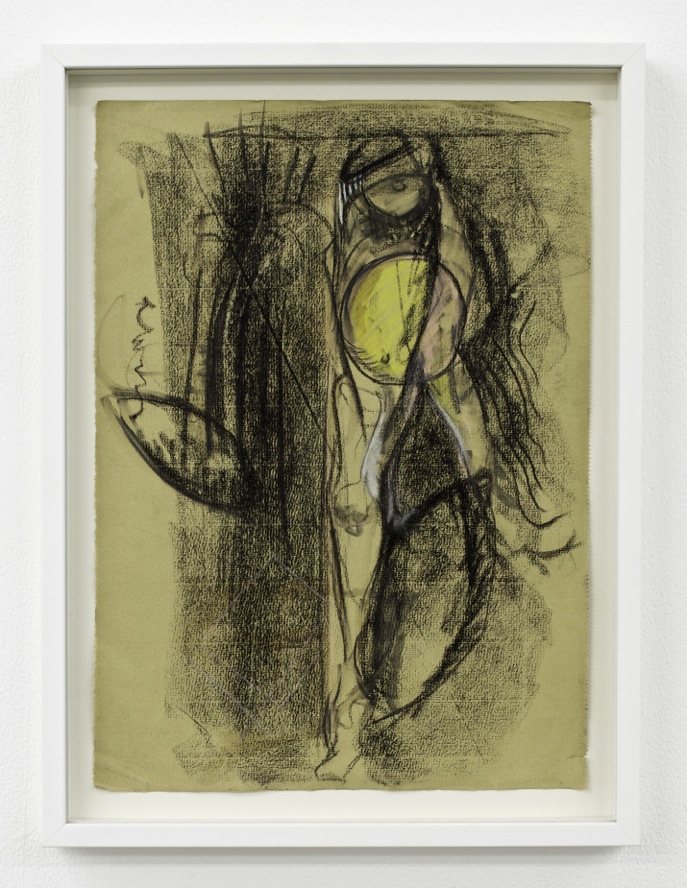
© » KADIST
Anne Imhof
Drawing & Print (Drawing & Print)
“School of the seven Bells (SOTSB)” is based on a series of hands games in which an object is passed from hand to hand. The performance is a reference to the film by Robert Bresson, “Pickpocket”, where a group of pickpocketers play with their victims. The artwork, through the actions of the hands, is an interrogation into space and time, questioning the relationship between public and private space, the establishment of communication through the body and visual exchange and gestures between aggression and sensuality.

© » KADIST
Ashmina Ranjit
While most of Ashmina Ranjit’s work has been large-scale installations, often immersive and site-specific, the series Hair Warp – Travel Through Strand of Universe is a brilliant concentration of both her beliefs and aesthetic. In this series, human hair is treated as a sacred element that connects womanhood and as Ranjit states, “all phenomena beyond the sky”. In the painting, the sinuous hair strands morph constantly into different braids, swirls, and landscapes, emitting a mysterious force of life.

© » KADIST
Polina Kanis
In the seminal video Workout , Kanis looks at the phenomenon of exercise in public space—specifically aerobics exercises in parks around Moscow today—as a broader lens for thinking about generational change. She leads a local group of participants through a work-shopped sequence of aerobics and marching. Each participant moves steadily and confidently in unison.

© » KADIST
Frieda Toranzo Jaeger
This triptych is based on a Tesla whose interior the artist customized on the Tesla website. The width of the work when the panels are closed is the exact width of a Tesla, thus one designed to hold two bodies side by side. In Mexico City the car is used as a social space and, for young people, one not controlled by parents.

© » KADIST
Julian Abraham
In 2015, while in residence at the Jatiwangi Art Factory (JaF) located in the village of Jatisura in Jatiwangi, West Java, Indonesia, Togar initiated the Jatiwangi Cup in which the artist, together with communities in the area, established an annual bodybuilding contest. The area is renowned for its roof tile factories, and the cup aims to celebrate the factory worker’s physiques, sculpted by intense, daily, physical labor. Togar based the idea of the cup on the simple notion of collectivity.
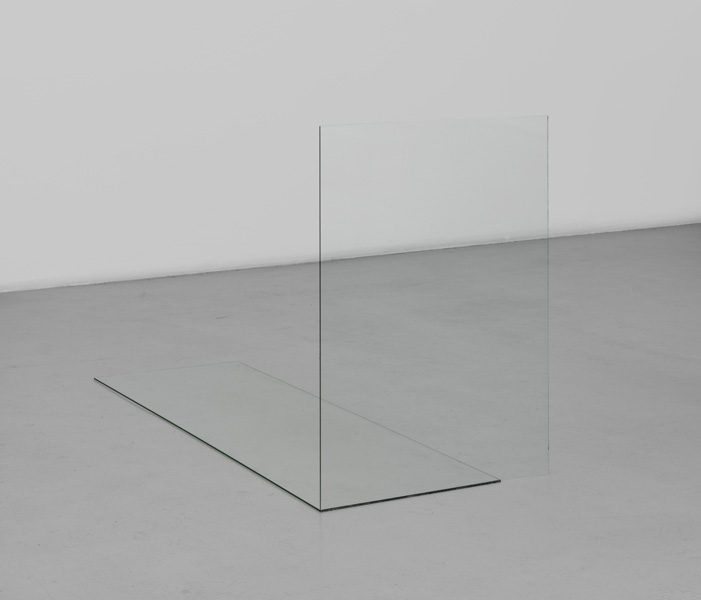
© » KADIST
Kitty Kraus
Composed of two rectilinear pieces of glass, this work is part of a series of sculptures started in 2006. These transparent assemblages are in contact with the walls and floor of the exhibition space. The sculptures of this series are the same dimensions with different combinations.

© » KADIST
siren eun young jung
Deferral Archive is one of the archival extensions of siren eun young jung’s Yeoseong Gukgeuk Project (2008-), a decade-long ethnographic research project into the diminishing genre of Korean traditional theater known as Yeoseong Gukgeuk . The genre, which was popular in the 1950s-60s, has since been forgotten, without ever being established as either a traditional or modern form of Korean theater. The most distinctive formal trait of Yeoseong Gukgeuk is that the theater performers are exclusively women.

© » KADIST
siren eun young jung
Drawing & Print (Drawing & Print)
Deferral Archive is one of the archival extensions of siren eun young jung’s Yeoseong Gukgeuk Project (2008-), a decade-long ethnographic research project into the diminishing genre of Korean traditional theater known as Yeoseong Gukgeuk . The genre, which was popular in the 1950s-60s, has since been forgotten, without ever being established as either a traditional or modern form of Korean theater. The most distinctive formal trait of Yeoseong Gukgeuk is that the theater performers are exclusively women.
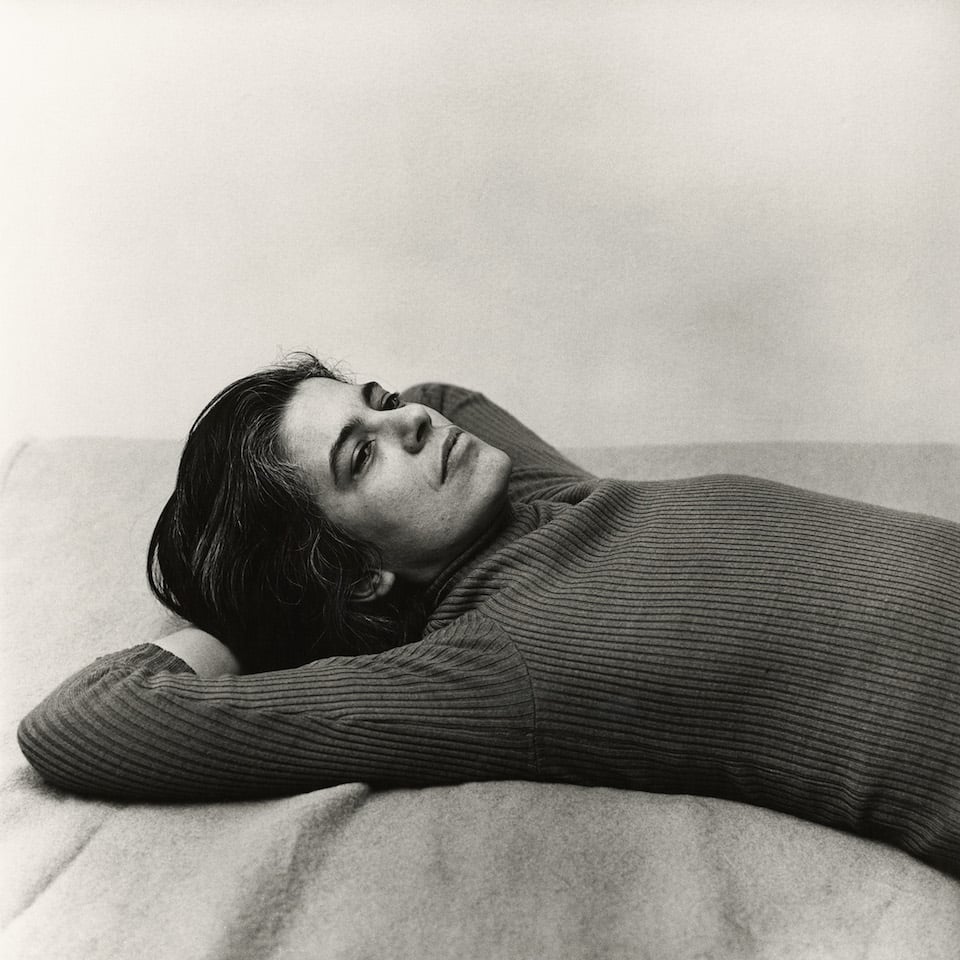
© » KADIST
Peter Hujar
Susan Sontag, the author of On Photography and Regarding the Pain of Others, was captured through Hujar’s now-iconic photograph in a relaxed yet pensive pose. A friend and supporter of his work as well as his subject, Sontag wrote the introduction for Hujar’s only book published during his lifetime: Portraits in Life and Death.

© » KADIST
Erika Verzutti
Made in cast bronze, Two Eyes Two Mouths provokes a strong sense of fleshiness as if manipulated by the hand of the artist pushing her fingers into wet clay or plaster to create gouges that represent eyes, mouths and the female reproductive organ. Equally, there is a semblance of fruits—their succulence and fragility. While the work is sensual, the matte bronze surface refuses any expectation of softness.
siren eun young jung
With a practice deeply engaged with feminism and LGBT rights issues, siren eun young jung reveals the subversive power of traditional culture, one unknown in the Korean modernization period, and provides unique perspectives and documentation of important communities...
James "Yaya" Hough
Working in ballpoint pen, pencil, and watercolor, often on the backs of bureaucratic prison forms, James “Yaya” Hough’s work conveys the burdens of incarcerated life, revealing not only the brutal reach of the carceral system, but laying bare its affects...
Zanele Muholi
- year born: 1972
- gender: female
- nationality: South African
- home town: Umlazi, Durban, South Africa
Laure Prouvost
Laure Prouvost is a multi-disciplinary artist best known for her films and immersive large-scale multi-media installations, in which she plays with words and their meanings in non-linear ways...
Amapola Prada
As the daughter of an actor, Amapola Prada recalls frequently attending the theater as a child and noticing that she never saw herself (her body or reality) represented...
Nontawat Numbenchapol
Nontawat Numbenchapol is primarily known as a film director and television screenwriter, widely recognized for his documentary work...
Kubra Khademi
Afghani artist Kubra Khademi uses her practice to explore her experiences as both a refugee and as a woman...
Danielle Dean
Danielle Dean creates videos that use appropriated language from archives of advertisements, political speeches, newscasts, and pop culture to create dialogues to investigate capitalism, post-colonialism, and patriarchy...
Nidhal Chamekh
Based between his native Tunis and Paris, Nidhal Chamekh’s work is an investigation into history as a point of access to our contemporary times...
Karla Kaplun
Karla Kaplun’s practice centers on micro-utopias, the construction and functioning of collective memory, as well as mechanisms of political and economic power and control...
John Wood and Paul Harrison
John Wood and Paul Harrison have been working collaboratively since 1993, producing single screen and installation-based video works...
Julian Abraham
Julian Abraham “Togar” is an artist, musician, and pseudo-scientist...
Sung Hwan Kim
In his practice, Sung Hwan Kim assumes the role of director, editor, performer, composer, narrator, and poet...
Sin Wai Kin
Through performance, moving image, writing, and print, artist Sin Wai Kin (formerly known as Victoria Sin) uses speculative fiction to interrupt normative processes of desire, identification, and objectification...
Shahryar Nashat
The work of Shahryar Nashat (b...
Seba Calfuqueo
Seba Calfuqueo is an artist of Mapuche origin whose work critically reflects on the social, cultural, and political status of the Mapuche people in contemporary Chilean society...
Tenzing Rigdol
Tenzing Rigdol is a contemporary Tibetan artist whose work ranges from painting, sculpture, drawing and collage, to digital, video installation, performance art and site-specific pieces...
Ashmina Ranjit
Ashmina Ranjit is Nepal’s leading figure in the conceptual and performance fields, as well as an emblematic voice in South Asian feminist art making and activism...
Wynnie Mynerva Mendoza Ortiz
Wynnie Mynerva is a non-binary artist based in Lima whose pictorial and performative practice is developed in close collaboration with the transgender and queer communities where they belong...
Jumana Manna
Jumana Manna is a Berlin-based artist whose work revolves around the body, national identity, and historical narratives...
Lynn Hershman Leeson
- location: San Francisco, California
- year born: 1941
- gender: female
- nationality: American
- home town: Cleveland, Ohio
Bo Wang
Through new media, installation, and video and film, Bo Wang’s practice embodies sociopolitical and cultural subjects in contemporary China and beyond...
Ruth Patir
Ruth Patir works with video and performances that complicate facile separations of public and private spheres...
Peter Hujar
Before American photographer Peter Hujar passed away from AIDS in 1987, he was a part of a group of New York-based artists, writers, and musicians who defined the downtown scene in the 1970s...
Rometti Costales
Rometti Costales is an artistic collaboration between Julia Rometti and Victor Costales that began in 2007...
Carolina Saquel Martinez
Caroline Saquel was born in Chile and now lives and works in Paris...
Li Shuang
Raised in rural south-eastern China in the 1990s, Li Shuang grew up consuming popular media such as YouTube, MySpace, knock off Nintendo consoles, pirated video games, and dakou CDs...
Alicia Smith
Alicia Smith is a Xicana artist and activist whose work thoughtfully engages with the subjects of indigeneity, colonialism, the environment, and the female body...
Lenora de Barros
Lenora de Barros studied linguistics and started her artistic career in the 1970s...
-
1970-1979
Peter Hujar
1975Susan Sontag, the author of On Photography and Regarding the Pain of Others, was captured through Hujar’s now-iconic photograph in a relaxed yet pensive pose...
-
1980-1989
Martha Araújo
1982In Habito/Habitante , the suspended material renders the wall a prison and the participant a prisoner...
Paz Errázuriz
1986La manzana de Adán (La Palmera, Santiago) by Paz Errázuriz is part of the celebrated series La manzana de Adán (Adam’s apple) that spans 5 years (1982-1987) of documenting the lives of transgender sex workers in La Jaula and La Palmera brothels in the Chilean cities of Talca and Santiago...
Karen Lamassonne
1989Ventana indiscreta (Rear Window) by Karen Lamassonne takes its title from Hitchcock’s renowned 1954 classic...
-
1990-1999
John Wood and Paul Harrison
1996One of John Wood and Paul Harrison’s earliest works, Device features Harrison performing a series of actions, assisted by the titular ‘devices’, that use physics to force his body into unusual and uncomfortable positions...
Douglas Gordon
1996In Monster (1996-97), the artist’s face becomes grotesque through the application of strips of transparent adhesive tape, typical of Gordon’s performance-based films that often depict his own body in action...
John Wood and Paul Harrison
19973-Legged is an early video work by John Wood and Paul Harrison in which they appear with their legs tied together (as one would do in a three-legged race)...
-
2000-2009
Patricia Belli
2000In the mid-1990s, Belli started to create soft sculptures that allowed her to reconnect with manual labor and sewing learned from her seamstress mother...
Prinz Gholam
2006Ein Ding Mehr , or ‘one more thing,’ is part of a long-term collaborative performance series by artists Wolfgang Prinz and Michel Gholam, which consist of the pair embodying an array of material through holding various poses for extended periods of time...
Lynn Hershman Leeson
2007Lynn Hershman Leeson’s genre-bending documentary Strange Culture tells the story of how one man’s personal tragedy turns into persecution by a paranoid, conservative, and overzealous government...
Kadar Brock
2007Kadar Brock creates dynamic abstract paintings that are born from a process of painting, scraping, priming, sanding, and painting again...
Daria Martin
2008In keeping with her mythological proclivity, Minotaur (2009) casts a new light on an old narrative...
Goddy Leye
2009In Goddy Leye’s installation work The Beautiful Beast , a video is projected onto a gold-colored wooden box filled with sesame seeds...
Bili Bidjocka
2009The short two-channel video Pause/Tanmpo takes its cue from a coincidental encounter artist Bili Bidjocka had in Dakar...
-
2010-2019
George Pfau
Drawing & Print
2010(Drawing & Print) This work exemplifies George Pfau’s interest in zombies and liminal embodiment...
Sung Hwan Kim
Drawing & Print
2010(Drawing & Print) This untitled drawing was part of Sung Hwan Kim’s solo exhibition Sung Hwan Kim: A Still Window From Two or More Places , which took place in tranzitdisplay in Prague, Czech Republic in 2010...
Sung Hwan Kim
Drawing & Print
2010(Drawing & Print) This untitled drawing was part of Sung Hwan Kim’s solo exhibition Sung Hwan Kim: A Still Window From Two or More Places , which took place in tranzitdisplay in Prague, Czech Republic in 2010...
Polina Kanis
2011In the seminal video Workout , Kanis looks at the phenomenon of exercise in public space—specifically aerobics exercises in parks around Moscow today—as a broader lens for thinking about generational change...
Clarisse Hahn
2011Prisons is part of a series of videos, entitled Our Body is a Weapon , representing individuals who affirm the body as a place of political and social resistance...
Angela Su
Drawing & Print
2011(Drawing & Print) From afar, Chimeric Antibodies by Angela Su may look like scientific drawings or botanical illustrations...
Yang Guangnan
2011Itch explores the relationship between technology and daily human experience with a motorized arm that extends from within the gallery’s wall, moving up and down while holding a projector that shows a desperately scratching pair of hands....
Danielle Dean
2012No Lye by Danielle Dean documents a group of five women, including Dean herself, confined to a small, cramped bathroom, communicating only by using slogans culled from beauty advertisements (“beauty is skin deep”, “naturalise, it’s in our nature to be strong and balanced”) and quotes from political speeches (“we must protect our borders”, “we are fighting for our way of life and our ability to fight for freedom”)...
Diane Simpson
2012Simpson’s sculptural practice connects architecture, clothing, furniture and the body to explore the functional and sociological roles and the influence of the design and architecture of various cultures and periods in history...
Leah Gordon
2012The Caste Portraits Series by Leah Gordon investigates the practice of grading skin color from black to white, which marked the extent of racial mixing in 18th century Haiti...
Amapola Prada
2013In Amapola Prada’s work Movement, we see three spotlit, female bodies lying inert in a darkened room, alongside three dressed, standing figures holding long, wooden spoons...
Anne Imhof
Drawing & Print
2013(Drawing & Print) “School of the seven Bells (SOTSB)” is based on a series of hands games in which an object is passed from hand to hand...
Carter Mull
2013Mull’s Worker’s Clock collage works bring together images from the artist’s studio photography practice, found photographs, and pages from a phone book, laying them over a psychedelic warp of color in the background...
Amapola Prada
2013In the video Unit/y we see Amapola Prada in the center of the screen wearing an oversized, worn out sweatshirt, socks and flip-flops—standing motionless on a dimly lit street in her native Lima, Peru...
Regina José Galindo
2013In 2012, former Guatemalan President José Efran Ros Montt was charged with genocide and crimes against humanity; Regina José Galindo’s video Tierra is a chilling reimagining of the atrocities recounted during his trial...
Rodney McMillian
2013In his evocative Landscape Paintings, McMillian uses second-hand bedsheets, sourced from thrift shops, as his starting point...
Collier Schorr
2013In the Collage II (Marie) (2013), Shorr seems to have an ostensibly clear subject, a female subject identified in the work’s title as “Marie,” a slim but athletic woman with brown hair pictured reclining atop a brilliantly white sheet draped against a marbled tan-and-white backdrop...
Cheryl Donegan
2013Fashion is the focus of Blood Sugar , which consists of a video projected onto a vintage vinyl jacket set at torso height on a dressmaker’s dummy...
siren eun young jung
2013Deferral Archive is one of the archival extensions of siren eun young jung’s Yeoseong Gukgeuk Project (2008-), a decade-long ethnographic research project into the diminishing genre of Korean traditional theater known as Yeoseong Gukgeuk ...
Amapola Prada
2013n the opening scene of the video Power (La Fuerza) we see a mature woman asleep in a dark room...
Sam Contis
2014Sam Contis’s photographs explore the relationship of bodies to landscape, and the shifting nature of gender identity and expression...
Shahryar Nashat
2014In the film Hustle in Hand (2014) we observe secret negotiations carried out between two characters with only their torsos visible in the frame— negotiations that consider fetishizations, meaning and symbolic value of the body and flesh...
Xiaoyun Chen
2014The central point of Vanishing Point is the most direct physiological reaction of the body to the environment...
Anna Boghiguian
2014In the painting called “The Consciousness of Memory, Time, and Guilt” as in many of her recent works, the body is fragmented...
Zanele Muholi
2014As a visual activist for the rights of Lesbian, gay, bisexual, transgender, queer and intersex (LBGTQI), Muholi’s photographs radically transgress the conventional perception of lesbian and transgender communities in South Africa...
Zanele Muholi
2014As a visual activist for the rights of Lesbian, gay, bisexual, transgender, queer and intersex (LBGTQI), Muholi’s photographs radically transgress the conventional perception of lesbian and transgender communities in South Africa...
Zanele Muholi
2014As a visual activist for the rights of Lesbian, gay, bisexual, transgender, queer and intersex (LBGTQI), Muholi’s photographs radically transgress the conventional perception of lesbian and transgender communities in South Africa...
Shahryar Nashat
2015Employing both the High Modernist technique of abstraction and monochronism, as in the work of Lucio Fontana and Yves Klein, and bodily states of fetishization, Yea High (sweetpreparator) reworks the art historical canon of movement and the body to consider flesh as a physical construction of man-made matter...
Adelita Husni-Bey
2015After the Finish Line is a recent film by Adelita Husni-Bey produced for the exhibition Movement Break at Kadist-SF in 2015...
siren eun young jung
2015Deferral Archive is one of the archival extensions of siren eun young jung’s Yeoseong Gukgeuk Project (2008-), a decade-long ethnographic research project into the diminishing genre of Korean traditional theater known as Yeoseong Gukgeuk ...
Erika Verzutti
2015Made in cast bronze, Two Eyes Two Mouths provokes a strong sense of fleshiness as if manipulated by the hand of the artist pushing her fingers into wet clay or plaster to create gouges that represent eyes, mouths and the female reproductive organ...
Nick Mauss
Drawing & Print
2015(Drawing & Print) As in other Mauss’ works that often look unfinished, the drawings in Untitled seem ever at the phase of the sketch, his segments as if they may uproot and reorient themselves at any moment...
Edie Fake
Drawing & Print
2015(Drawing & Print) Related to Edie Fake’s Memory Palaces series — reimagined facades of urban lesbian bars and gay nightclubs — Personal Business draws an association between architecture and the body, with ornamental structures that are decorative and protective...
Aimée Zito Lema
2015Rond de Jambe by Aimée Zito Lema is a series formed by two works: a three-channel video installation and a live performance...
Gabriella and Silvana Mangano
2015There is no there by Gabriella and Silvana Mangano is a black and white looped video with sound, in conjunction with a live performance...
siren eun young jung
Drawing & Print
2015(Drawing & Print) Deferral Archive is one of the archival extensions of siren eun young jung’s Yeoseong Gukgeuk Project (2008-), a decade-long ethnographic research project into the diminishing genre of Korean traditional theater known as Yeoseong Gukgeuk ...
Ruby Sky Stiler
2015The depiction of the female figure in the sculptures remains an economic, canny composition of geometric abstractions in a Modernist spirit...
Jumana Manna
2015Blue Elbow (Coude bleu) is made from plaster, burlap, lacquer, pigments and plastics...
Danielle Dean
2015Hexafluorosilicic acid is a type of sodium fluoride waste product that can be found in a large amount of widely available products such as cleaning fluids, toothpaste, rat poison, and drinking water...
Cally Spooner
2016The installation Self Tracking (the five stages of grief) was realized from a performance that is to be re-activated...
Nidhal Chamekh
Drawing & Print
2016(Drawing & Print) Nidhal Chamekh made the first drawings of the ongoing series Mémoire Promise in 2013...
James "Yaya" Hough
Drawing & Print
2016(Drawing & Print) This untitled ink and pencil drawing by James “Yaya” Hough is made on what the artist calls “institutional paper”, or the state-issued forms that monitor the daily activities of prisoners, of which, each detainee is generally required to fill out in triplicate...
Nidhal Chamekh
Drawing & Print
2016(Drawing & Print) Nidhal Chamekh made the first drawings of the ongoing series Mémoire Promise in 2013...
James "Yaya" Hough
Drawing & Print
2016(Drawing & Print) This untitled ink and pencil drawing by James “Yaya” Hough is made on what the artist calls “institutional paper”, or the state-issued forms that monitor the daily activities of prisoners, of which, each detainee is generally required to fill out in triplicate...
James "Yaya" Hough
Drawing & Print
2016(Drawing & Print) This untitled ink and pencil drawing by James “Yaya” Hough is made on what the artist calls “institutional paper”, or the state-issued forms that monitor the daily activities of prisoners, of which, each detainee is generally required to fill out in triplicate...
Marcel Pardo Ariza
2016In Linda, Lee & Dorsey, Louis (1988~, 2018) Marcel Pardo Ariza draws on Bay Area queer histories that have been uncovered from local archives and queer organizations, and connects them to people currently living in the Bay, where Ariza is also based...
Seba Calfuqueo
2017Alka domo by Seba Calfuqueo is a performative video work that recontextualizes a story about Caupolicán, the Mapuche toki (meaning symbol of strength and perseverance in the face of adversity)...
Sin Wai Kin
Drawing & Print
2017(Drawing & Print) A woman you thought you knew by Sin Wai Kin originates from a performance series titled A View from Elsewhere ...
Frieda Toranzo Jaeger
2017This triptych is based on a Tesla whose interior the artist customized on the Tesla website...
Mika Tajima
2017Mika Tajima’s Pranayama sculptures are built from carved wood and chromed Jacuzzi jets and are presented as artefacts...
Wolfgang Tillmans
2017Wolfgang Tillmans initiated the ongoing series Faltenwurf in 1989, representing compositions of unused clothing, with special attention paid to the ways in which they drape and fold...
Farah Al Qasimi
2017Farah Al Qasimi’s approach to photography deviates from the norms and conventions of traditional figurative and portrait photography...
Laura Gannon
2017The impressionistic surface of Wild Money (2017) recalls the 1950s paintings of Philip Guston...
Laure Prouvost
2017The Parle Ment Metal Woman Welcoming You is a character originated from a series of works combining sculpture and video with a specific role— lying on the floor playing a romantic elevator tune, this Metal Woman welcomes and flirts with viewers in the space where she is posed...
Christina Quarles
2018The title of the painting refers to the fact that the figure’s behind is raised upwards and the face is found at the bottom of the painting, thus inverting the way in which people are normally seen...
John Lucas and Claudia Rankine
Drawing & Print
2018(Drawing & Print) Historically, blondeness has been a signifier for desirability and beauty, speaking to “purity” — the purity of whiteness — like no other bodily attribute except, perhaps, blue eyes...
siren eun young jung
Drawing & Print
2018(Drawing & Print) Deferral Archive is one of the archival extensions of siren eun young jung’s Yeoseong Gukgeuk Project (2008-), a decade-long ethnographic research project into the diminishing genre of Korean traditional theater known as Yeoseong Gukgeuk ...
Alicia Smith
2018The title of Alicia Smith’s video work, Teomama , means “God Carrier” in the Aztec language of Nahuatl...
Matt Mullican
Drawing & Print
2018(Drawing & Print) Mullican’s Stick Figure Drawings depict characters reduced to their most basic graphic representation...
Sin Wai Kin
2018The video Tell me everything you saw, and what you think it means by Sin Wai Kin is from a performance series titled A View from Elsewhere...
Francisca Benítez
2018You have given the world your songs by Francisca Benítez is a poem in American Sign Language (ASL)...
Laure Prouvost
2018Monteverdi Ici – Deeply, Feeling Filling the World by Laure Prouvost is a tapestry that references a video by the artist entitled Monteverdi Ici (2018)...
Andrew Ekins
2018Butter Mountain is part of an ongoing series of works that combines a sense of painterly mass and substance with sculptural language to examine the synergy between a topographical landscape and a landscape of the human condition...
Cecilia Bengolea
2018Lightning Dance by Cecilia Bengolea is a black and white video that considers the relationship between extreme weather and the body...
Judith Hopf
2018Hopf’s works reference the effects that developments in economics and technology have had on our bodily and mental composition...
Laure Prouvost
2018Monteverdi Ici by Laure Prouvost is a non-narrative video work that depicts the back of the artist’s naked body standing, with her back towards the camera in a field...
Maryam Hoseini
2019Secrets Between Her and Her Shadow 10 by Maryam Hoseini is from a series of paintings of the same title that are inspired by the story Layla and Majnun – an Arabic love story about Majnun, a 7th century Bedouin poet, and his lover, Layla...
Tenzing Rigdol
2019Unhealed by Tenzing Rigdol is a photograph of the artist’s back tattooed with a map of Tibet with the dates of important political events...
Karla Kaplun
Drawing & Print
2019(Drawing & Print) Studying the body in movement, this series of drawings depart from Karla Kaplun’s work A ztec BLAST® Workout (AWB) ...
Julian Abraham
2019In 2015, while in residence at the Jatiwangi Art Factory (JaF) located in the village of Jatisura in Jatiwangi, West Java, Indonesia, Togar initiated the Jatiwangi Cup in which the artist, together with communities in the area, established an annual bodybuilding contest...
Julian Abraham
2019In 2015, while in residence at the Jatiwangi Art Factory (JaF) located in the village of Jatisura in Jatiwangi, West Java, Indonesia, Togar initiated the Jatiwangi Cup in which the artist, together with communities in the area, established an annual bodybuilding contest...
Ruth Patir
2019Historical representations of the female form and the clichés and misunderstandings that surround them have been the subject of recent research and historical revision...
Alicia Henry
2019Out of simple materials, Alicia Henry creates enigmatic, somewhat troubled characters, which reveal her interest in the complexities and the contradictions surrounding familial relationships...
Rometti Costales
2019Canción para un fósil canoro (Song for a chanting fossil) by Rometti Costales is inspired by the history of the building that currently hosts the Museo de la Solidaridad Salvador Allende (MSSA) in Santiago, Chile...
Diego Bianchi
2019Diego Bianchi’s main concern is distorting straight lines, both literally and metaphorically...
He Xiangyu
2019He Xiangyu’s Terminal 3 presents excerpts from the lives of young African acrobats attending the Hebei Wuqiao Acrobatic Arts School in China...
Marina Rosenfeld
2019The installation Music Stands: Free Exercise 7, 8, and 9 by Marina Rosenfeld consists of music stand-like structures and a corresponding set of panels and acoustic devices that direct, focus, obstruct, reflect and project sound in the gallery...
Karla Kaplun
Drawing & Print
2019(Drawing & Print) Studying the body in movement, this series of drawings depart from Karla Kaplun’s work A ztec BLAST® Workout (AWB) ...
Mandy El-Sayegh
2019Mandy El Sayegh grew up in a medicalized environment, surrounded by anatomy, biology and psychology publications; these books inspire the figures that appear throughout her work...
Elena Tejada-Herrera
2019Las Bambas by Elena Tejada-Herrera takes the name of a copper mine in the Andean department of Apurímac, Peru...
-
2020-2029
Ashmina Ranjit
2020While most of Ashmina Ranjit’s work has been large-scale installations, often immersive and site-specific, the series Hair Warp – Travel Through Strand of Universe is a brilliant concentration of both her beliefs and aesthetic...
Manuel Solano
2020Since Manuel Solano became blind, they developed a technique that relies on audio descriptions that allow for an assistant to place pins and threads on a grid that guides the artist’s hands through the surface...
Nikita Gale
2020RUINER III by Nikita Gale is part of an on-going numbered series of abstract sculptures in which various ancillary materials necessary for sound production and recording such as towels, foam, and audio cables, are riddled around piping resembling crowd control bollards, lighting trusses, and other like stage architecture...
Jes Fan
2020The Diagram series relates broadly both to Jes Fan’s interests in body modification and gender hacking as well as the artist’s investment in destabilizing hegemonic categories such as gender, monogamy, and the classical individuated subject in favor of more creative, egalitarian, and communal modes of envisioning ourselves...
Juliana Góngora
2020Lengüitas sagradas (Blessed Little Tongues) by Juliana Góngora is the result of a careful creative job between Juliana Góngora and the Koreguaje community and their workshop Masipai...
Andrew Norman Wilson
2020Z = |Z/Z•Z-1 mod 2|-1: Lavender Town Syndrome by Andrew Norman Wilson is a multi-channel video that uses three different imaging technologies—a photographic lens, photorealistic ray tracing animations, and fractal ray-marching animations—to travel through three constructed environments...
Kubra Khademi
Drawing & Print
2020(Drawing & Print) Kubra Khademi’s work celebrates the female body and in her detailed drawings and paintings she portrays female bodies floating on white paper...
Kubra Khademi
Drawing & Print
2020(Drawing & Print) Kubra Khademi’s work celebrates the female body and in her detailed drawings and paintings she portrays female bodies floating on white paper...
Eduardo Navarro
2020The installation Breathspace by Eduardo Navarro encompasses all the content presented at the artist’s first solo exhibition, of the same name, at Gasworks, UK...
Jung Yoonsuk
2020Tomorrow by Jung Yoonsuk is a two-channel video installation, observing the two different sites of factories, one in the mannequin reform factory in Seoul, Korea, and the other in a sex doll factory in Shenzhen, China...
Kubra Khademi
Drawing & Print
2020(Drawing & Print) Kubra Khademi’s work celebrates the female body and in her detailed drawings and paintings she portrays female bodies floating on white paper...
Minia Biabiany
2020Musa is a visual and textual work by Minia Biabiany and the starting point of a broader research around the sexuality of Caribbean women, the historical legacy of slavery, and the artist’s own female lineage...
Gisela McDaniel
2020Got Your Back by Gisela McDaniel depicts two women of color from different ethnic backgrounds who share similar violent experiences...
Antonio Obá
2020Figura Noturna II by Antônio Obá depicts a dark figure, surrounded by a halo of light set against an even darker background...
Lu Yang
Advanced Technology
2021(Advanced Technology) The Great Adventure of the Material World Knight by Lu Yang is a video game world in which an androgynous protagonist goes on a hero’s journey to overcome their understanding of the material world as a coherent, objective truth...
Lenora de Barros
2021Lenora de Barros’s poetics are known for setting in motion an intimate relationship between image and the written word...
Phoebe Collings-James
2021The Subtle Rules the Dense is a series of masks/torsos/body plates that Phoebe Collings-James cast from mannequins and then worked by hand...
Nathan Lewis
Drawing & Print
2021(Drawing & Print) Nathan Lewis has always made figurative and abstract drawings, which are related to anatomical textures and patterns he encountered when working as an ICU nurse...
Sylbee Kim
2021Sylbee Kim’s Unindebted Life is a single-channel video, commissioned and premiered at the 13th Gwangju Biennale (2021)...
Leyla Stevens
2021Leyla Stevens’s two-channel video Patiwangi, the death of fragrance is an immersive video installation that addresses erased histories...
Anne Imhof
2021Anne Imhof’s video work Untitled (Wave) creates resonances between the feminine, adoration, and immateriality, while also referring to the history of art and aesthetics, in particular the concept of the sublime...
Pratchaya Phinthong
2022Pratchaya Phinthong’s work has explored the mineral and karmic economies of Laos, a country that shares language, beliefs, and a long border with his own native region of Isaan (Northeast Thailand)...
davi de jesus do nascimento
Drawing & Print
2022(Drawing & Print) davi de jesus do nascimento’s earthy paintings, from the series sorvedouro , recall his memories as an essentially organic matter...
Joshua Serafin
2022Through the language of dance and choreography, Void by Joshua Serafin narrates the creation of a new God, the birth of a futuristic deity...
Wynnie Mynerva Mendoza Ortiz
2022Wynnie Mynerva places their body at the center of their practice from an intimate perspective and healing dimension...
















